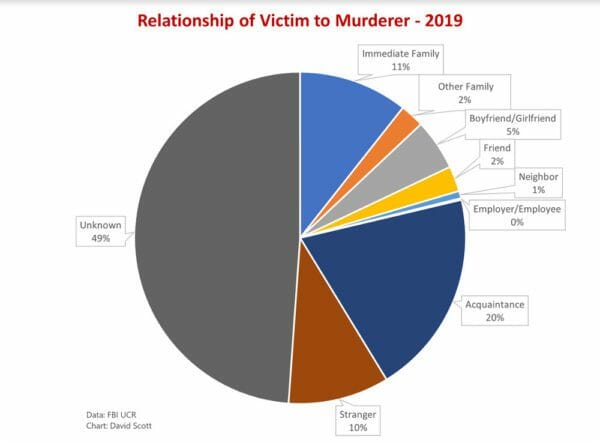U.S.A. –-(AmmoLand.com)- Those who follow the debate on restoring Second Amendment rights have probably heard the other side proclaim some variant of:
“Most victims are murdered by people they know.”
The implication is defending yourself from a murderer is futile because there is no point in trying to defend yourself from a person who is close to you. This is a way of lying with statistics. The truth is far different.
Few Victims Are Murdered By Someone They Live With.
In 2013, this correspondent published an essay on the Misleading Murderer that you Know. The numbers were from 2010. This article uses numbers from the FBI Uniform Crime Reports (UCR) for 2019.
The most accurate crime statistics involve homicides, particularly murders. The most easily solved homicides are murders of passion between intimates. The hardest homicides to solve are those with no connection between the murderer and the victim.
The largest category of victims in the FBI reports of victim relationships to their murderer is unknown. In 2019, those victims are 49% of the total. It is a huge number. Some of this is because FBI Uniform Crime Reports (UCR) are often filed before an investigation is complete. As murders of passion among intimates are the easiest to solve, this means a much higher percentage of strangers and acquaintances fall into the unknown category when the UCR report is filled out.
The clearance rate for murder in 2019 was 59%. This means 41% were not solved. About 84% of the murderers who are unknown by the time of the UCR report remain unknown. Likely, most of the 16% solved are not intimate partner murders. Those that are are unlikely to have been living with their victim.
The clearance rate for murder in 2020 dropped to 54.4%.
So-Called Known Murderers
The next largest category of murderers is acquaintances. It is 20%. These are included in people you “know”.
The slightest connection to you counts as you “knowing” them. The gang-banger who was in your remedial English class in community college, the drug dealer you filed a report about, the laborer who cleaned up your neighbor’s yard, the person who involved you in a fender-bender, the high school classmate who was always in trouble, are all counted as an acquaintance. So are addicts’ suppliers, criminals’ associates, and gang members.
The next largest category is members of the immediate family. They are 11%. This is who most people place in the category of “known.” This includes estranged and ex-family, such as ex-wives and ex-husbands.
Then come strangers, at 10%. These are the hardest murderers to catch.
- Boyfriend/girlfriend is at 5%. This includes ex-boyfriends/girlfriends.
- Other family is 2%.
- Friends are at 2%.
- Neighbors are 1%
Employers/employees are just a trace, at .16%, too small to show up on the chart.
Acquaintances Aren’t Family
To create the misleading statistic that most murderers are “known” to their victims, those who want you to believe self-defense is futile include acquaintance with family, friends, and neighbors.
Then to inflate the “known” numbers, they assume the unknown murderers have the same percentage of immediate family and relationships as those where the relationship is known. It is a bad assumption.
Applying the misleading math used by Gun Control Advocates to the 2019 figures creates the false figure that 80% of murderers are “known” to their victims.
A more realistic appraisal is unknown, stranger and acquaintance categories make up 79% of murderers. Of the remaining 21%, many are ex-spouses, ex-boyfriends/girlfriends, and estranged family and friends.
The numbers of exes and estranged are not reported. A great many domestic homicides occur between ex-spouses, ex-boyfriends/girlfriends, and estranged others.
When determined, it is likely that the number of people who murder someone living with them will be less than 10% of the total.
More and more people are effectively defending themselves against people they know who have become deadly enemies.
Knowing someone doesn’t mean you cannot defend against them. Legal measures such as restraining orders make a self-defense claim clearer to police, prosecutors, and courts. This correspondent refers to these as cases of domestic defense.
Taking a quick look, 20 cases of domestic defense were reported by the media in the last three months. The vast majority involved firearms as a defensive tool, where the attackers were wounded or killed. Most defensive uses likely do not result in shots fired or in people wounded or killed. Most are not reported to the police, and of those reported, few are mentioned in the media. Actual domestic defense uses of guns are probably 50-100 times greater than those reported in the media.
Self-defense against intimates is almost never counted as justified homicide in the FBI UCR, because of the extremely limited definition of justified homicide the UCR uses.
The bottom line: Firearms are effectively used for self-defense when confronting known and unknown attackers. Don’t fall for the anti’s propaganda war hide the truth.
About Dean Weingarten:
Dean Weingarten has been a peace officer, a military officer, was on the University of Wisconsin Pistol Team for four years, and was first certified to teach firearms safety in 1973. He taught the Arizona concealed carry course for fifteen years until the goal of Constitutional Carry was attained. He has degrees in meteorology and mining engineering and retired from the Department of Defense after a 30-year career in Army Research, Development, Testing, and Evaluation.
from https://ift.tt/75IeULf
via IFTTT


No comments:
Post a Comment